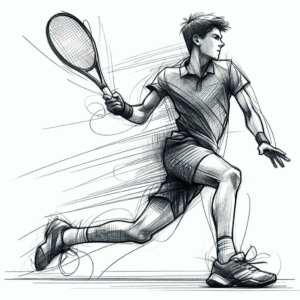Key Lessons from the Club Championships Semifinals
The Manly Club Championships featured two competitive singles semifinals on Court 1 last week, with excellent tennis conditions marred slightly by the challenging sun in the later match, particularly for serves from the southern end.
In the first match, Rimmo defeated Sean, while in the second, Andre prevailed over Oliver. Both victors demonstrated a clear tactical advantage by taking control of rallies early, often using a deep, well-placed bunt return on the service return to seize the initiative. This neutralizing approach in returning, coupled with solid baseline play, proved decisive.
Both matches saw ALL players relying heavily on powerful first serves to earn quick points. However, missed first serves frequently invited the receiver into a rally from the kick second serve, leading to a higher-than-usual number of service breaks.
In his match, Rimmo was content to draw Sean into extended rallies, often resetting points with a backhand slice even though it allowed Sean to move aggressively inside the baseline. Sean, an agile player, might have benefited from finishing points earlier, by adopting a more assertive approach, the “Nadal variation” to finish the point.
Conversely, Andre used his height and powerful ground strokes to consistently pressure Oliver. By drawing short balls from Oliver, Andre was able to transition forward, either finishing points with a well-placed ground stroke or setting up an easy volley. Andre’s volleys remain an area for potential improvement. Oliver did not capitalize on opportunities to apply pressure with angled passing shots or lobs, particularly given the challenging sun conditions.
Rimmo’s game was anchored by his world-class backhand and impressive retrieval skills, which consistently frustrated his opponent. However, his tendency to muscle his serves raised concerns about the risk of re-injury to his shoulder.
Both winners established an early control on most points, setting the tone for their respective matches. In contrast, Sean and Oliver spent too much time engaging in powerful baseline exchanges, with many shots landing well inside the baseline, allowing their opponents comfortable rally balls. Effective shot depth was noticeably absent, with few shots driving opponents onto their back foot to elicit errors or short balls.
Both players missed valuable opportunities to attack from inside their respective ghost lines, frequently choosing passive rally shots instead of taking control of the point. Their approach emphasized executing a solid stroke rather than strategically setting up the point through varied shot combinations and intentional court placements.
All players aimed to secure quick points through first-serve winners, but as the balls wore down, opponents gradually adjusted to the serve’s pace, making returns easier, particularly in the match’s later, critical stages. Employing variety in serve placement, speed, and spin proves far more effective in disrupting an opponent’s timing on the return. Over-reliance on raw power for first serves not only raises error rates but also forces players into hitting a greater percentage of second serves. It’s often said that a player’s game is only as strong as their second serve.
Finally, neither Sean nor Oliver seemed to recognize their opponents’ passive approach to first serve returns. Implementing serve-and-volley tactics could have transformed these rallies, and a well-placed serve and follow-up volley could have created straightforward winners.





